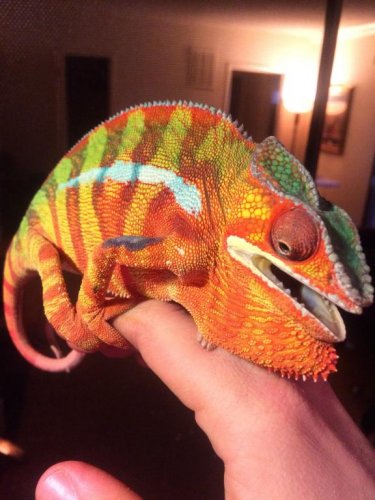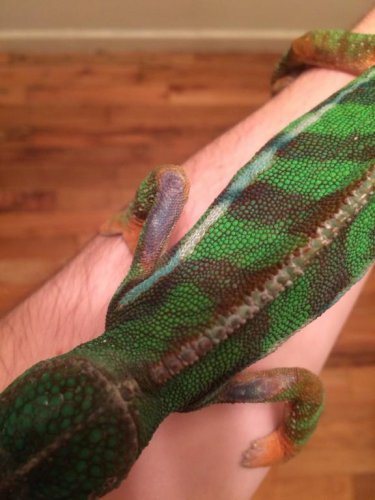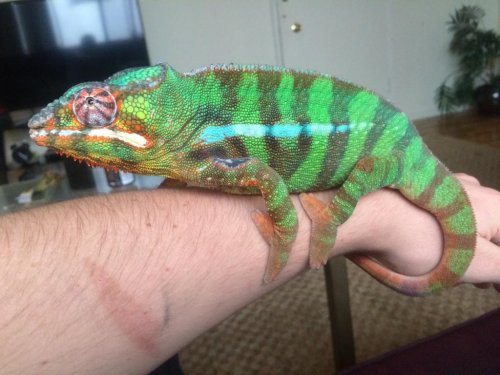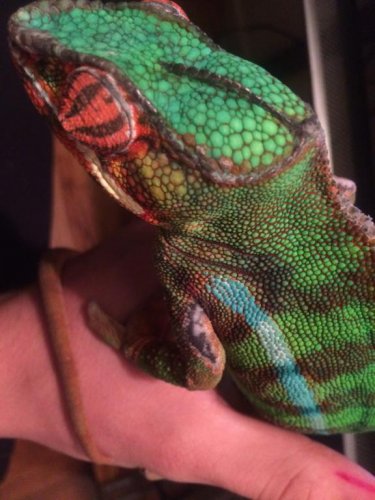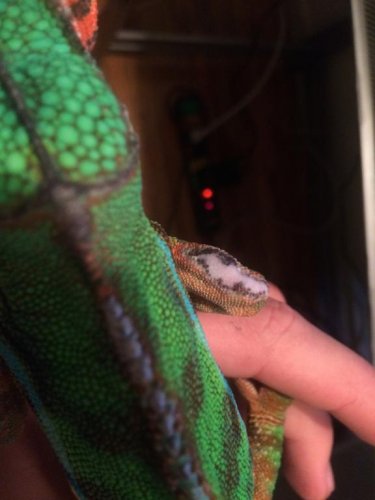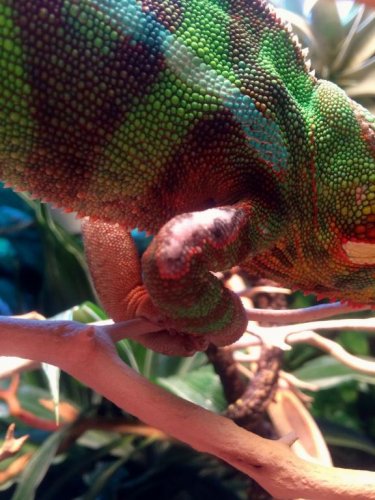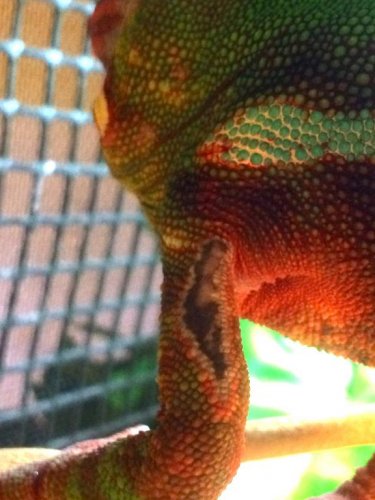Dbash44
Avid Member
UPDATE AND ISSUE:
Back in January, my male panther, Mango, had some purple spots on the tops of his front arms that were weirdly symmetrical. I took him to the vet on February 1, and applied the disinfectant and antifungal they gave me for the next two months twice a day (vet said it was most likely fungal infection). In the last few months I do notice the spread of the discoloration to have diminished a bit. What's weird is the way the skin looks around the discoloration now. There seems to be a row of white pigment followed by orange. The skin also looks bubbly or blistery, but there's no inflammation from what I see. When I touch the marks he seems to be in zero pain. He's shed probably three times or so since the vet. He eats eagerly and loves to climb around and be held whenever I say hi to him when I get home.
DIET AND SETUP:
I try to take him out in direct sunlight once or more a week if I get home before dark. On top of that I feed him Calcium D3 twice a month and Multivitamin twice a month and Calcium with NO D3 every day the others aren't used. I just bought new D3 a week and a half ago seeing as the one I've used since I got him over a year ago was expired. He loves hornworms which I have recently started feeding him every other week and will eat one dubia but not very often; crickets are the staple diet. I gutload the crickets with Mustard Greens, Carrots, Squash, Melon, and bugburger as a dry food source.
As far as water, I have an automatic mister set up that goes off every two hours for around two minutes with distilled water. I was told that the distilled water sucks nutrition from them, so I have started using Reverse Osmosis water in the dripper as opposed to the distilled. I also change water and clean dripper everyday seeing as it is inside the cage. Excess water is removed from cage through drainage system.
His feces and urate seem to be healthy from what I've researched. Nice and white and all.
I just replaced his Reptiglo CFL UVB with the Reptisun low profile T5 5.0 HIGH OUTPUT linear. And his heat bulb was a 75w heat lamp, but i just switched it up to a 70w house bulb cause I saw him gaping while he was basking.
As far as furnishings go, I have had ficus trees in the past that seem to not do well after a few months, and have currently switched to a dracena. On top of that I use artificial plants and have a tiliansia, pothos, and scheffelera. Not seen him chomp on the leaves or the organic soil.
Other than that, he sleeps normally and seems hydrated so I don't think the spots bug him.
TO WRAP IT UP:
What should I do about these spots? I read bruises or burns can be permanent, which I don't mind 'cause they add character IMO; I just want to make sure he'll be ok in the long run. Maybe some sort of Vitamin A for skin health, but I fear he'll OD if I try that.
Back in January, my male panther, Mango, had some purple spots on the tops of his front arms that were weirdly symmetrical. I took him to the vet on February 1, and applied the disinfectant and antifungal they gave me for the next two months twice a day (vet said it was most likely fungal infection). In the last few months I do notice the spread of the discoloration to have diminished a bit. What's weird is the way the skin looks around the discoloration now. There seems to be a row of white pigment followed by orange. The skin also looks bubbly or blistery, but there's no inflammation from what I see. When I touch the marks he seems to be in zero pain. He's shed probably three times or so since the vet. He eats eagerly and loves to climb around and be held whenever I say hi to him when I get home.
DIET AND SETUP:
I try to take him out in direct sunlight once or more a week if I get home before dark. On top of that I feed him Calcium D3 twice a month and Multivitamin twice a month and Calcium with NO D3 every day the others aren't used. I just bought new D3 a week and a half ago seeing as the one I've used since I got him over a year ago was expired. He loves hornworms which I have recently started feeding him every other week and will eat one dubia but not very often; crickets are the staple diet. I gutload the crickets with Mustard Greens, Carrots, Squash, Melon, and bugburger as a dry food source.
As far as water, I have an automatic mister set up that goes off every two hours for around two minutes with distilled water. I was told that the distilled water sucks nutrition from them, so I have started using Reverse Osmosis water in the dripper as opposed to the distilled. I also change water and clean dripper everyday seeing as it is inside the cage. Excess water is removed from cage through drainage system.
His feces and urate seem to be healthy from what I've researched. Nice and white and all.
I just replaced his Reptiglo CFL UVB with the Reptisun low profile T5 5.0 HIGH OUTPUT linear. And his heat bulb was a 75w heat lamp, but i just switched it up to a 70w house bulb cause I saw him gaping while he was basking.
As far as furnishings go, I have had ficus trees in the past that seem to not do well after a few months, and have currently switched to a dracena. On top of that I use artificial plants and have a tiliansia, pothos, and scheffelera. Not seen him chomp on the leaves or the organic soil.
Other than that, he sleeps normally and seems hydrated so I don't think the spots bug him.
TO WRAP IT UP:
What should I do about these spots? I read bruises or burns can be permanent, which I don't mind 'cause they add character IMO; I just want to make sure he'll be ok in the long run. Maybe some sort of Vitamin A for skin health, but I fear he'll OD if I try that.

